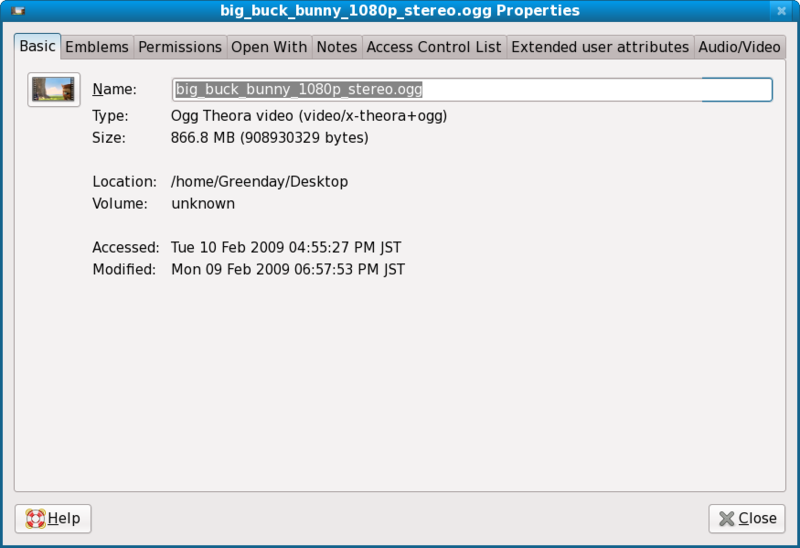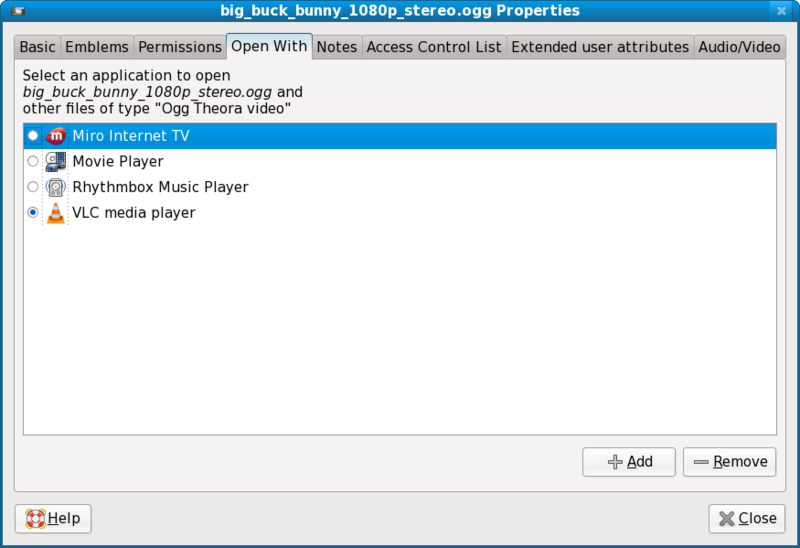Difference between revisions of "VLC HowTo/Make VLC the default player"
(→Mac) |
(→Windows: Add a method.) |
||
| Line 1: | Line 1: | ||
== Windows == | == Windows == | ||
| + | On any folder with a toolbar, click on ''Tools'' then ''Folder Options''. Select the ''File Types'' tab. | ||
| + | One can select and set any default program for any registered file type from that section. | ||
| + | |||
| + | ''E.g.'', if there is a "DVD Video" in the list as there is for MS Windows XP, select it then click the ''Advanced'' button. | ||
| + | |||
| + | A new window, ''Edit File Type'', will open and the list of known, compatible executable programs will be presented. | ||
| + | |||
| + | Select the one desired, in this case, ''Play with VLC media player'', and then click the ''Set Default'' button. | ||
| + | |||
| + | Next, click ''OK'' and then ''Close'' to close the ''Edit File Type'' window. | ||
| + | |||
| + | One can repeat that for as many files as needed before clicking the "Close" button. E.g., perhaps the "AudioCD" would be useful to set for VLC. | ||
| + | |||
| + | ( Please note that this ''File Types'' location is *'''''not'''''* a place to play. Change what is needed and only that. I.e., one can look but do not touch unless you intend to buy it, :). ) | ||
== Mac == | == Mac == | ||
Revision as of 05:42, 2 February 2010
Contents
- 1 Windows
- 2 Mac
- 3 Linux
- 3.1 Fedora
- 3.1.1 GNOME
- 3.1.1.1 Instructions on how to do it in GNOME.
- 3.1.1.2 Changing the default application for videos using menus(the easy way):
- 3.1.1.3 Changing the default application for videos using menus(the not so easy way):
- 3.1.1.4 Changing the default application for videos manually(the hard way):
- 3.1.1.5 References
- 3.1.2 KDE
- 3.1.1 GNOME
- 3.1 Fedora
Windows
On any folder with a toolbar, click on Tools then Folder Options. Select the File Types tab. One can select and set any default program for any registered file type from that section.
E.g., if there is a "DVD Video" in the list as there is for MS Windows XP, select it then click the Advanced button.
A new window, Edit File Type, will open and the list of known, compatible executable programs will be presented.
Select the one desired, in this case, Play with VLC media player, and then click the Set Default button.
Next, click OK and then Close to close the Edit File Type window.
One can repeat that for as many files as needed before clicking the "Close" button. E.g., perhaps the "AudioCD" would be useful to set for VLC.
( Please note that this File Types location is *not* a place to play. Change what is needed and only that. I.e., one can look but do not touch unless you intend to buy it, :). )
Mac
Right click on the type of file you want to always open in VLC. Click 'Get Info'. In the 'Open With' section, select VLC from the drop down menu. To apply this change to all files of this type, click the 'Change All' button.
Linux
Fedora
GNOME
Gnome uses two lists (located at /usr/share/applications/) mimeinfo.cache and defaults.list, to register applications to file types.
So you could either edit it manually or use the tools that GNOME has for this.
Instructions on how to do it in GNOME.
System -> Preferences -> Personal -> Preferred Applications -> Multimedia -> Custom -> Type this: vlc %U
ps: not tested yet.
| * Right-click on the video file that you want VLC to open. * Choose properties. * Now in the properties window click on the tab named Open With.  |
* In the tab Open With just choose VLC as your player for that type of file. Just remember that you will have to do this for each an every type of video/audio file(ex: mpg, avi, rm, mkv, ogg, mp3 etc)  |
* If the VLC icon don't show up on the Open With tab, click on the add button in the lower corner to the right of the window tha has a plus sign, and locate VLC on the window tha pops up that is called Add Application.  |
Changing the default application for videos manually(the hard way):
In Fedora 10 the path /usr/share/applications/ will take you to these 2 files that configure what application open a type of file.
defaults.list
mimeinfo.cache
ps:
Both files will point to a Desktop Entry file([name of the file].desktop) that is inside the applications folder, and the 2 important things inside that file are the configurations for what MIME Types the application can handle and how to launch the application.
A Desktop Entry file is a data file that provides information about an item in a menu.
The desktop entry specification describes desktop entries as files describing information about an application such as the name, MIME Types it handles, icon, and description. These files are used for application launchers and for creating menus of applications that can be launched.
If you don't have the VLC Desktop Entry file or it disapear for some reason you will have to make one. Look here for some pointers.
You only need to modify mimeinfo.cache, I hope. It works here if It don't work for you please edit this.
So what you have to do is:
- Open mimeinfo.cache as root.
- Search for the MIME Types for video.
- Change all of them to use VLC.
ex:
Registry of MIME Type (video/quicktime) in mimeinfo.cache to use VLC.
video/quicktime=livna-vlc.desktop;totem.desktop;miro.desktop;
The format is:
[MIME Type]=[Name of the Desktop Entry file]
Note: You can put more then one Desktop Entry but they need to be separated by a semi-colon (;), see the example above.
Those extra entries will appear as options when you right-click on the video file and go to the Open With submenu.
Tip: Nautilus don't show the real names of the Desktop Entry files. Either drag and drop it on gedit so you see the name on the tab or use ls to list the files on the command line.
References
Registering Applications for MIME Types (Editing defaults.list and mimeinfo.cache)